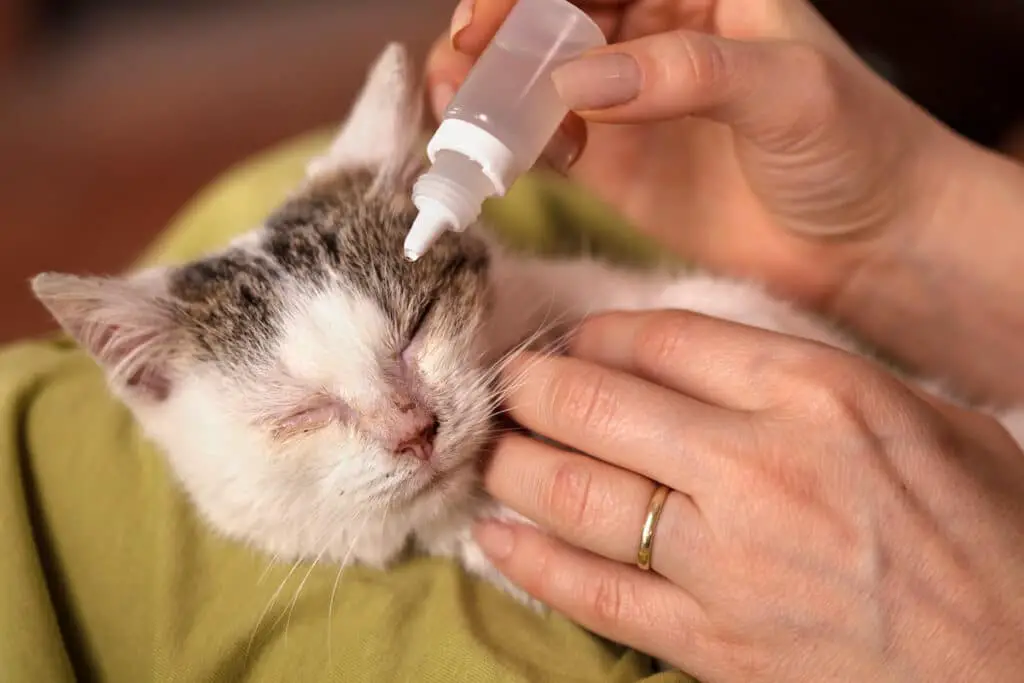Symptoms of a Cat Eye Infection: Cats are susceptible to a variety of eye disorders. These include Feline Herpesvirus, Anterior Uveitis, Blepharitis, and Conjunctivitis. Fortunately, there are several treatment options available to you.
Conjunctivitis
Symptoms of cat eye infection and conjunctivitis include redness, pawing at the eye, excessive blinking, and discharge. If left untreated, the infection can cause permanent damage to the eye.
If you suspect your cat has conjunctivitis, contact your veterinarian immediately. They can check the eye with an ophthalmoscope. They may also do tests to determine if there are other eye conditions. They can measure the pressure within the eye, the amount of tear production, and other factors.
If the infection is caused by a virus, your veterinarian may prescribe antiviral drugs. Your vet may also prescribe antibiotic eye drops or ointments.
You may also be advised to give your cat a lysine supplement or probiotics to help boost its immune system. These may help prevent the infection from returning.
Blepharitis
Usually, cat eye infections are treated by a combination of antiviral and antiparasitic treatments. However, the type of parasite involved in the infection will determine the specific type of treatment that will be necessary.
Blepharitis is an inflammation of the eyelids. It can be caused by a number of different factors, including allergies, infections, and tumors. When it is not treated, it can cause pain and a reduction in vision. It can also cause a cat to scratch its face more often, which can further damage the eyelids.
Symptoms include eye discharge, swelling, and itching. When a cat has blepharitis, the skin covering the eyelid may be swollen and red. It may also be covered with pustules.
The eye is an organ that can reveal important information about the body. It is made up of several different types of tissue. It contains the iris, which covers the pupil, and the cornea, which is the clear part of the eye.
Anterior uveitis
Several types of infectious diseases can cause anterior uveitis in cats. This condition can be painful and is best treated with proper medication administration.
The uvea is an area of the eye that consists of several structures. These structures include the iris, the ciliary body and the choroid. Several diseases can cause anterior uveitis in cats, including Feline Immunodeficiency Virus (FIV), Feline Leukemia Virus (FeLV) and Toxoplasmosis.
Anterior uveitis in cats is typically treated symptomatically until a cause is identified. If the underlying cause is determined, specific therapy may be prescribed. The treatment plan includes anti-infective and topical medications to reduce inflammation. If the disease is systemic, additional tests may be necessary.
A thorough ocular examination is needed to make a proper diagnosis. This examination should include systematic evaluation of all ophthalmic structures. A detailed history and physical examination will help determine the underlying cause of the disease.
Feline Herpesvirus
During a feline herpesvirus infection, the virus can infect the cornea, lining of the nose and bones associated with the mouth. Symptoms can include coughing, wheezing, nasal discharge and conjunctivitis. Feline herpes virus can be passed on from one cat to another through contact with secretions and airborne particles.
The symptoms of feline herpes virus can be mild or severe, and can last from weeks to months. Cats with chronic herpes viral ocular disease may need to take topical antiviral medications to decrease the severity of the recurrent infection.
Feline herpesvirus infection can be diagnosed through laboratory testing. The most sensitive method is polymerase chain reaction (PCR) testing. This test is conducted by taking a swab of the tissues around the eye and sending it overnight to a laboratory. The test results are typically received within 7-10 days.
Allergies
Symptoms of cat eye allergies can vary from one cat to another. The most common symptom is watery eyes. Symptoms can also include redness and discharge.
Cat eye allergies can be caused by many factors, including environmental exposure. If your cat is experiencing symptoms, it is best to consult a veterinarian. The veterinarian will perform a complete ophthalmic exam to determine the cause of the problem. The vet may refer you to a cat eye expert if necessary.
The most common symptoms of allergies in cats are watery eyes and redness. These are caused by the cat’s immune system reacting to a specific allergen. The immune system produces antibodies that attack the allergen. The immune system is also responsible for releasing other chemicals to protect the eyes.
Another symptom of allergies is a rash on the neck or upper chest. The rash can be caused by dust mites, pollen, or household cleaning products.














